RBA Annual Conference – 2016 Discussion
- Download 161KB
1. James Laurenceson
Harry Wu's paper presents a sombre assessment of China's total factor productivity (TFP) performance. Between 1980 and 2012, the average annual growth rate of TFP is estimated to have been just 0.83 per cent, accounting for only 9 per cent of the growth in output. Moreover, TFP growth has been on a declining trend. It averaged 1.63 per cent over 1992–2001, fell to 1.19 per cent over 2002–07, and then dropped sharply to –2.06 per cent over 2008–12. Aside from providing new estimates of TFP growth, the paper also makes a valuable contribution to the literature by attempting to disaggregate China's TFP performance by sector. Some sectors were found to have performed far worse than others. For example, in 2012 the level of TFP in the energy sector was less than half that in 1980. Wu attributes China's poor TFP performance to government interference in resource allocation, particularly at the local level, and inefficient state-owned enterprises (SOEs). I offer two points of reflection that I hope will promote further discussion of what is a well-constructed and thought-provoking paper.
First, in the Chinese context, TFP isn't everything. Krugman (1994) observed that: ‘Productivity isn’t everything, but in the long run it is almost everything. A country's ability to improve its standard of living over time depends almost entirely on its ability to raise its output per worker'.
Output per worker, or labour productivity, is the measure of productivity that defines living standards. In China, labour productivity has increased 15-fold since 1978 (Figure 1). Moreover, its growth rate has hardly slowed. This is confirmed by Wu, who shows that between 2008 and 2012 labour productivity increased at an average annual rate of 8.5 per cent, faster than in any previous sub-period apart from 2002–07.
Yet even with this rapid growth, China's potential for further ‘catch up’ is evidenced by the fact that in 2015 labour productivity had still only reached around one-eighth of that in the United States and one-third of that in South Korea (Figure 2). It also lags behind other large developing countries, such as Brazil.
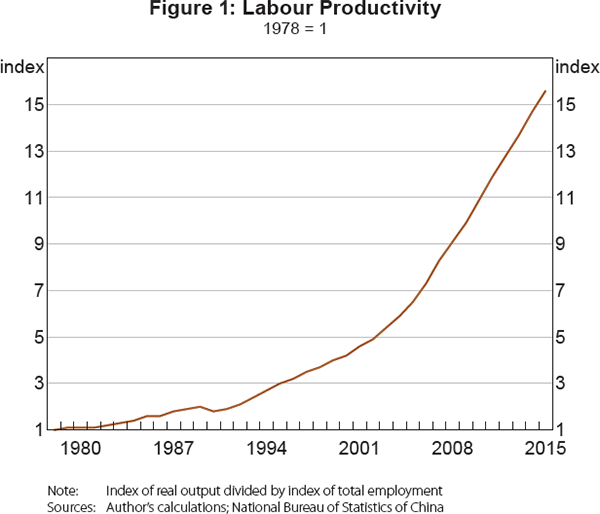
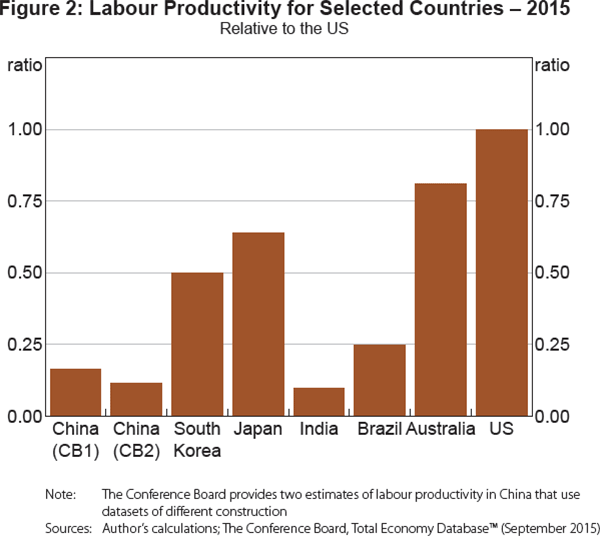
Given China's stage of development, there is nothing unexpected or inherently wrong with improvements in labour productivity being driven in large part by increases in capital per worker (i.e. capital deepening) rather than TFP. Indeed, one of the main reasons that labour productivity in China lags behind higher income countries is because capital per worker remains relatively low. In 2011, capital per worker in China was just one-fifth of that in the United States and one-quarter of that in South Korea (Figure 3). For countries that already have a high capital-per-worker ratio, diminishing returns to capital means that TFP is the key to delivering additional improvements in living standards. But Figure 3 suggests that China may not be in this situation yet.
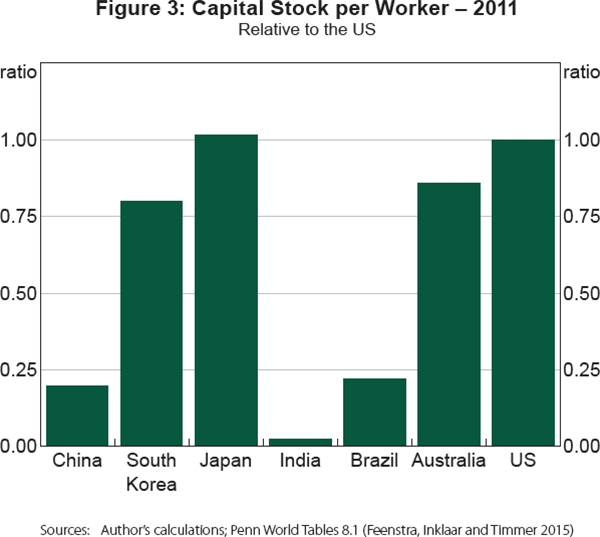
To further illustrate this point, if the aggregate economy can be represented by a Cobb-Douglas production function, then the marginal product of capital (MPK ) – the extra output from one additional dollar of investment – can be estimated as the ratio of output to the capital stock, multiplied by the capital share of output (Dornbusch et al 2013). Figure 4 shows that while the MPK in China has fallen in recent years, it is still not abnormally low in a historical context and, as economic theory predicts, remains much greater than in countries such as Japan and South Korea, where the capital-to-worker ratio is higher. This is not to say that investment in China has always been productive: examples of capital misallocation can easily be found. What Figure 4 points to is that the fundamental returns potentially on offer for investment remain substantial.
To summarise the above argument, China does not so much need to invest less and obsess over TFP. Rather, it needs to focus on investing more efficiently. Of course, faster TFP growth would also be desirable. It would, for example, contribute to an improvement in living standards without the huge environmental costs that have accompanied rapid growth in the past.
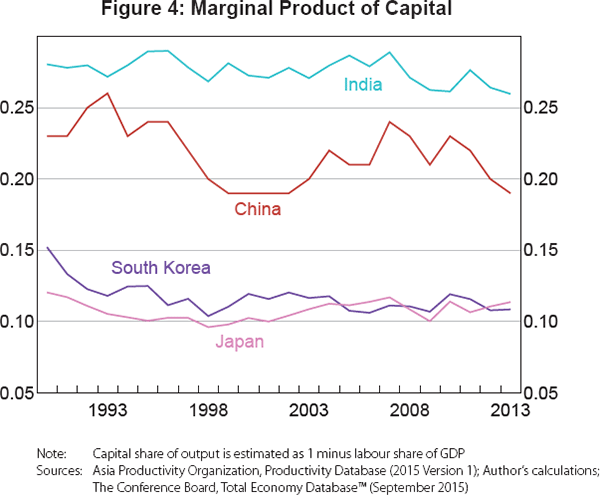
A second point of reflection is that, unlike labour productivity, TFP is notoriously difficult to measure and highly sensitive to the selection of data and methodology. This has proven to be the case when TFP has been estimated at the national and provincial levels in China (Laurenceson and O'Donnell 2014). Figure 5 presents a range of TFP estimates for China and several other economies. Wu estimates that the level of TFP was around 18 per cent higher in 2012 than it was in 1990. The corresponding estimates by others are 9.7 per cent for the first Conference Board measure, 77.6 per cent for the second Conference Board measure and 170 per cent for the Asia Productivity Organization estimate. Aside from the huge variation in TFP estimates for China, the other salient observation is that even the lower estimates of China's TFP performance do not stand out as being particularly abnormal in an international context.
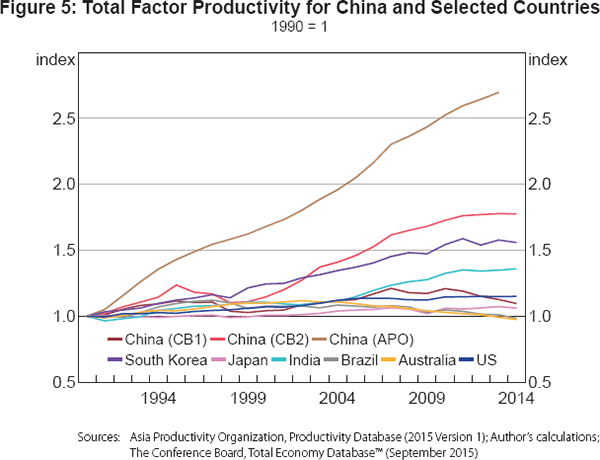
Faced with such a divergence in TFP estimates, it is useful to take a step back and consider whether those at the lower (or upper) end of the spectrum appear plausible given what else we know about China's economic development experience. Wu is surely correct to assert that elements of government intervention and inefficient SOEs have acted as a drag on China's TFP performance. But Lardy (2014) also documents that it is now private sector firms that produce more than two-thirds of GDP, have accounted for all of the growth in employment since 1978 and that generate a rate of return on equity several times higher than SOEs. These private firms face hard budget constraints. Lardy (in this volume) adds the important point that the private sector has continued to grow in relative importance in recent years. By 2014, state firms were only responsible for 8 per cent of investment in manufacturing, down from 11 per cent in 2012. The share of investment by state firms in services was higher at 43 per cent, but still down from 45 per cent in 2012.
McMillan and Naughton (1992) also noted that a key lesson to come from China's reform experience is that what matters for improving productivity is not the privatisation of SOEs but subjecting them to competition. In some sectors of the economy, such as in upstream oil and gas, telecommunications and finance, SOEs retain monopoly positions. But in other sectors they now compete fiercely with each other and with private sector firms. Lardy (2014) cites the example of the coal industry, which in 2011 comprised 880 SOEs and 4,420 private companies. At an aggregate level, the degree of business concentration in many sectors of China's economy is now lower than in the United States (World Bank and DRC 2013). Such stylised facts are hard to square with estimates of TFP that show only marginal improvement.
References
Dornbusch R, P Bodman, S Fischer and R Startz (2013), Macroeconomics, 3rd Australian edn, McGraw-Hill Education, North Ryde.
Feenstra RC, R Inklaar and MP Timmer (2015), ‘The Next Generation of the Penn World Table’, The American Economic Review, 105(10), pp 3150–3182. Available for download at <www.ggde.net/pwt>.
Krugman PR (1994), The Age of Diminished Expectations: U.S. Economic Policy in the 1990s, 2nd edn, The MIT Press, Cambridge.
Lardy NR (2014), Markets over Mao: The Rise of Private Business in China, Peterson Institute for International Economics, Washington DC.
Laurenceson J and C O'Donnell (2014), ‘New Estimates and a Decomposition of Provincial Productivity Changes in China’, China Economic Review, 30, pp 86–97.
McMillan J and B Naughton (1992), ‘How to Reform a Planned Economy: Lessons from China’, Oxford Review of Economic Policy, 8(1), pp 130–143.
World Bank and DRC (World Bank and Development Research Center of the State Council, the People's Republic of China) (2013), China 2030: Building a Modern, Harmonious, and Creative Society, World Bank, Washington DC.
2. General Discussion
The estimates of TFP presented in the paper were generally well received by participants, with discussion focused primarily on the interpretation of the paper's results. In response to the discussant's comments, Harry Wu emphasised his view that TFP growth is necessary and important for long-run growth. He noted that weak TFP growth in recent years should encourage Chinese authorities to undertake more structural reforms.
One key topic of discussion was the role of government intervention and structural reform in influencing TFP growth. One participant mentioned that the timing of shifts in industry-level TFP growth does not always line up with the timing of reforms in that sector. For example, agricultural TFP was relatively flat through the reforms of the agricultural sector in the 1980s and growth of energy sector TFP has been weak since the SOE reforms began in the 1990s. Similarly, another participant argued that it is difficult to reconcile the recent strong TFP growth in the agriculture sector with the idea that government is a major cause of low TFP growth, as the effective protection rate and government intervention in the agricultural sector has increased during this period. Another participant wondered if strong growth in TFP in the agricultural sector was a result of catching up to advanced economies or if the growth of TFP in this industry was normal by international standards. Professor Wu replied that measurement of the agricultural sector is difficult, particularly due to issues around quantifying land productivity and the treatment of the self-employed. He suggested it was plausible that true TFP growth in this sector could be lower than his estimates and that more work should be done in this area.
Several participants commented on the result of a decline in TFP since the global financial crisis. One participant noted that the result of weak TFP growth in China since 2007 is not surprising, but there are several different interpretations. This participant suggested that most observers view negative TFP growth as the result of ongoing distortions in factor prices caused by government intervention and conclude that China's growth model could be ‘running out of steam’. An alternative explanation was that, as China is approaching the ‘middle-income trap’, sectors that previously drove growth (such as heavy industry) are becoming less efficient, experiencing substantial overcapacity and contributing to weak productivity growth.
This participant questioned the notion that local governments were responsible for the recent negative TFP growth, noting that their incentives have been largely unchanged since the 1990s. Along these lines, the participant suggested that the paper could be improved by including some quantitative measure of government intervention at the industry level or by providing a narrative of government intervention.
Another participant discussed possible effects of the macroeconomic stimulus in response to the global financial crisis on TFP growth. Firstly, the participant wondered how the large increase in infrastructure spending by governments in this period would influence long-run growth in China. Secondly, the participant questioned whether the effects of the housing boom are fully captured in the Chinese GDP data (given the difficulty of accurately capturing components such as housing services) and therefore how downwardly biased estimates of the level of GDP would affect the paper's results.
One participant questioned what negative TFP growth in recent years could imply about the health of the private sector. The participant suggested that either the state sector's negative TFP growth has overcome the private sector's positive TFP growth; or that TFP growth in the private sector is also negative (having been led into inefficient industries by local governments). In response to the general comments about the effect of government intervention, Professor Wu explained that the dataset cannot give an exact measure of state or non-state ownership, although he is working to add this dimension in the future. He also noted that many private sector firms were also subject to government intervention in China, even if indirectly.
One participant wondered if the recent negative TFP growth in China can be explained in part by China's recent focus on environmentally friendly growth. If the authorities have directed investment into less efficient, but more environmentally friendly energy-producing technology, an additional unit of output would require more capital than otherwise, implying lower observed TFP growth.
As a historical comparison, one participant noted that this debate mirrors the debate around east Asian TFP growth in the 1990s. The participant argued that weak TFP growth implies that the return to capital and labour should be low or falling and that this is difficult to reconcile with data presented by the discussant, which showed a high and relatively stable return to capital.
Finally, another participant asked if technology embedded in capital imported into China will be reflected in these estimates of productivity. Professor Wu explained that this embedded technology would be captured in his measure of capital stock. The participant also posited that state intervention into some sectors, such as energy, could be positive, as it creates lower intermediate input prices and thus supports rapid capital accumulation.